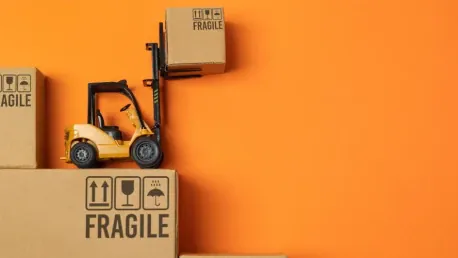The collaborative robot (cobot) industry is undergoing a significant transformation, driven by technological advancements and a competitive market. Manufacturers like Universal Robots, Doosan Robotics, and Techman Robot are at the forefront, striving to create cobots that are lighter yet capable of handling greater loads. This quest for innovation is set to redefine industrial automation, particularly in logistics. As companies increasingly seek to optimize productivity and reduce labor costs, cobots are emerging as key players in this evolving landscape, blending seamlessly into human workflows and undertaking strenuous, repetitive tasks.
Market Dynamics and Growth
The cobot industry’s rapid expansion is evident in the projected market growth. The robot arms market is expected to surge from $2.2 billion in 2021 to an impressive $10.2 billion by 2026. This vigorous growth is mainly fueled by the increasing adoption of automation and robotics across various sectors, especially logistics. Leading the charge are palletizing robots, which sort, transfer, and stack goods onto pallets, streamlining operations and boosting efficiency. Automation’s role in logistics cannot be overstated; as enterprises strive to improve efficiencies and reduce reliance on manual labor, cobots are quickly becoming essential tools.
Cobots have been meticulously designed to work alongside human employees, performing repetitive and strenuous tasks, thus allowing workers to pivot towards more strategic activities. This symbiotic relationship between humans and cobots is pivotal to industrial transformation. By enhancing operational efficiencies and significantly reducing the strain of manual labor, these robots offer both productivity gains and considerable cost savings. Companies adopting cobots can expect to see not only a boost in operational throughput but also a marked improvement in workplace safety and job satisfaction among employees.
Technological Advancements and Innovations
Technological advancements are at the heart of the cobot industry’s evolution, setting the stage for unprecedented growth and innovation. Universal Robots has recently unveiled an upgraded version of its UR30 cobot, which boasts a maximum payload of 35 kg, the highest globally for cobots of similar weight. This remarkable achievement is realized through sophisticated software enhancements, underscoring the industry’s emphasis on maximizing performance without increasing physical weight. The enhanced UR30 marks a major milestone in cobot development, showcasing how software innovations can drive significant improvements in hardware capabilities.
Moreover, the upgraded UR30 maintains the same weight as its predecessor at 63.5 kg, making it the lightest cobot capable of such a high payload. This balance between weight and capacity positions the UR30 as a leading product in the competitive landscape. Competing products from Doosan Robotics and Techman Robot also offer high payload capacities but are heavier than the UR30, highlighting Universal Robots’ competitive edge. The ability to enhance payload capacity without adding extra weight is a critical factor in the performance and versatility of cobots, particularly for applications in logistics where both agility and lifting power are essential.
Competitive Analysis
The competition among cobot manufacturers is intense, with Universal Robots, Doosan Robotics, and Techman Robot leading the pack. These companies are intensely focused on creating cobots that exceed 30 kg lifting capacities while weighing under 100 kg. This competition is not solely about who can carry the heavier load but also about maintaining agility and ease of use, which are crucial for logistics and other applications. As these manufacturers strive to one-up each other in terms of payload capacity and weight efficiency, the market is witnessing rapid technological progress.
Universal Robots’ innovative approach places it ahead in terms of both payload capacity and weight efficiency. However, Doosan Robotics and Techman Robot are not too far behind, continually refining their products to close the gap. This rivalry drives technological advancements, yielding benefits for industries that depend on automation. Companies in sectors like logistics gain access to more advanced, capable, and versatile cobots. The ongoing competition ensures that the market remains dynamic and pushes the boundaries of what cobots can achieve, thereby enhancing their integration into industrial workflows and boosting overall efficiency.
Applications and Practical Benefits
The practical benefits of cobots extend across various sectors, with logistics standing out as a key area of application. Cobots are increasingly substituting manual labor in tasks such as picking up and unloading products within automated guided vehicles (AGVs). This shift towards automation streamlines operations and improves workplace safety and efficiency. Reducing the reliance on human labor for hazardous tasks is not only a strategic move but also a necessary one to enhance productivity and minimize risks associated with manual handling of heavy items.
Ergonomic benefits are another significant advantage offered by cobots. Lifting heavy loads over 35 kg poses serious risks of musculoskeletal disorders to human workers. Cobots addressing these challenges play a crucial role in enhancing worker safety and reducing injury-related downtime. As companies become more conscious of the need to protect their workforce while maintaining high efficiency, the adoption of cobots is proving to be a prudent and forward-thinking strategy. By leveraging cobots for heavy-duty tasks, businesses can ensure safer work environments and more sustainable operational practices.
Industry Opinions and Market Impact
The collaborative robot (cobot) industry is witnessing a major transformation due to cutting-edge technological advancements and a highly competitive market. Leading manufacturers such as Universal Robots, Doosan Robotics, and Techman Robot are pioneering efforts to design cobots that are not only lighter but also capable of handling heavier loads. This drive for innovation is poised to revolutionize industrial automation, especially within the logistics sector.
As businesses increasingly aim to boost productivity and cut labor expenses, cobots are becoming essential in this evolving landscape. Unlike traditional robots, which often operate in isolated environments, cobots are designed to integrate smoothly into human workflows. They are capable of performing strenuous and repetitive tasks that would otherwise take a toll on human workers.
By collaborating directly with humans, cobots enhance efficiency and workplace safety. Their ability to work alongside people without the need for extensive safety measures makes them ideal for a variety of applications, from assembly lines to warehouses. As the demand for automation continues to rise, cobots are set to become even more integral to modern industry, rendering processes more streamlined and cost-effective.









